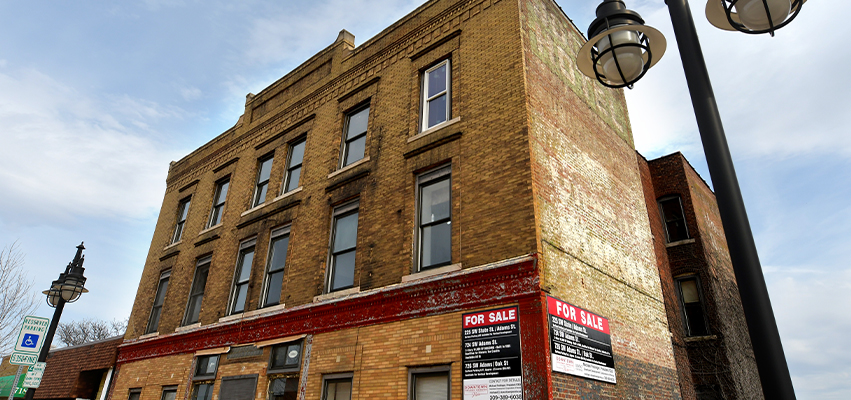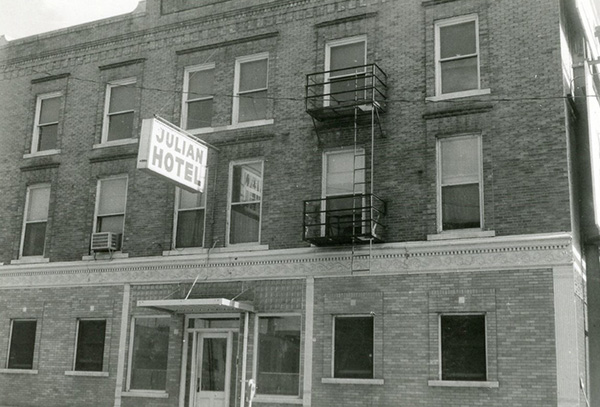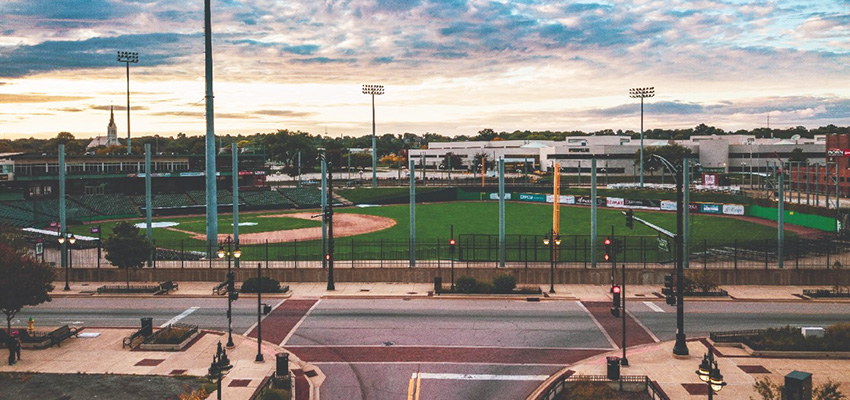
Architecture aficionados can fall in love in with a structure as bold, bedazzling, even breathtaking. But the object of my architectural ardor isn’t anything like that. Rather, it seems more bedeviled, bedraggled and broken down.
The Julian Hotel might be on its last legs, though there’s still a chance the ol’ gal could undergo one of the most remarkable makeovers this town has ever seen.
The Downtown Development Corp., which owns the property and two others in the 700 block of Southwest Adams Street, has the hotel on the market. Though 127 years old, the shuttered structure – the last of Peoria’s flophouses – still has a chance to be resuscitated for condos or a boutique hotel.
“I think it could,” says Michael Freilinger, who heads the DDC. “But is it financially feasible?”

Collection Center, Bradley University Library
My wistful interest in the Julian, 724 SW Adams St., comes through no rose-colored glasses. Though Peoria’s yesteryear boasted hotels steeped in glitz and glamor, the brick-hewn Julian was a plain Jane, sturdy and stout.
The workaday design and appearance allowed the hotel to long countenance what became a rough-and-tumble customer base. As far back as the 1950s, police routinely would investigate the hotel or its inhabitants for various transgressions and troublemaking, usually more of an annoying nuisance than a serious public threat.
Tenants – renting tiny, sparse rooms by the month, week or day – included all sorts of people on the fringes of society, from bottle-tipping old-timers to suddenly jobless teen moms, many of them one step from homelessness.
As a police reporter when I first came to Peoria in the late 1980s, I got to know some of them — on the streets, in taverns and via police reports. “The people in the hotel are the people no one wants,” one of the hotel’s owners told me back then. “God knows what brings ‘em down here. Some tragedy in their lives.”
Though some were far from angels, I came to appreciate how their survival mode created a communal bond. “The people of this hotel, whether they’re black or white, have a sense of family … of brotherhood,” the owner said. “They’re all in the same boat. They’ll help out anyone from the neighborhood being harassed by people not from here.”
Never overflowing with good fortune, the Julian ran out of luck in 2002. After failing a federal housing inspection, it was shut down for good. That same year, the Peoria Chiefs’ ballpark opened across the street, with proponents promising a transformation of the area into the local version of Chicago’s Wrigleyville. That didn’t happen.
In 2017, a fledging developer bought the property for a mere $25,000. Grand plans abounded for 20 units of luxury apartments complete with doorman and valet parking, with retail space on the first floor possibly to include a restaurant. Those plans fizzled, too.
Though the rest of the Warehouse District had begun to boom, the Julian fell back asleep. In late 2020, after working quietly behind the scenes, the DDC issued a wake-up call. The not-for-profit, which works with the city, businesses, property owners and others to promote and develop Downtown, bought the Julian for $150,000.
Freilinger sees the site as promising, perhaps in connection with two nearby DDC-owned properties. One is the parking lot next door, at the corner of Adams and Oak streets. The other is another parking lot at the opposite end of the block, which is leased to an apartment landlord.
The 700 block of Southwest Adams Street consists of six lots, each about a quarter acre. The DDC’s three are bookends to three privately owned commercial spots. For a while, the DDC had hoped to pitch the entire lot in a private/public deal, perhaps to land a development whale-like Walgreens or CVS, but the commercial owners decided not to pursue it.
Six months ago, the DDC put its three lots up for sale, $200,000 apiece. Right away, offers came in to buy the parking lots and maintain them as such. The DDC wasn’t interested. “What we would like to see is redevelopment,” said Freilinger, who envisions a three-story development with apartments or condos on the top two floors and retail space below.
“Residential is hot,” he said, and the north lot makes sense for developers looking for opportunity on a smaller scale. One possibility is a rooftop garden overlooking Dozer Park. That’s not possible from the Julian, as sightlines and the ballpark configuration partially obscure the view.

On the south side, the DDC would like to package the Julian and adjacent parking lot together. The building qualifies for federal and state tax credits of 45 percent of rehab costs. Here’s the tricky part: Does rehab make more sense than knocking the place down and starting over?
Often, such tax credits mean a developer must buy and install custom-made structural components (cornices, window moldings, etc.) that follow the construction of a bygone era, sometimes making repair costs untenable. Old buildings are nice, but sometimes they outlive their practical usefulness. Better to develop the site anew than watch it decay further.
Freilinger says there is “active interest” in the Julian property. It’s possible a deal could move forward by summer. Here’s hoping.
I realize the Julian boasts no architectural significance. It’s not as if Lincoln slept there. But many others did, amid hardscrabble struggles just to get from one day to the next. Nettlesome as some might’ve been, many brimmed with a survivor spirit, just like the Warehouse District itself.
If the Julian Hotel can be revived, it would harken back not only to a bygone era but serve as a testament to gritty staying power. Sometimes, if the plan and price are right, gritty can be just as attractive as pretty.

Phil Luciano is a senior writer/ columnist for Peoria Magazine
and content contributor to public television station WTVP

